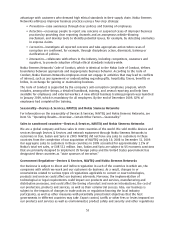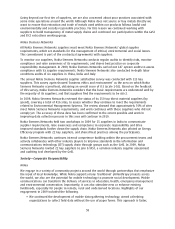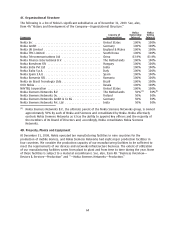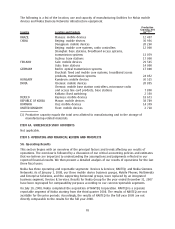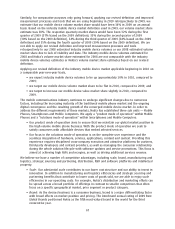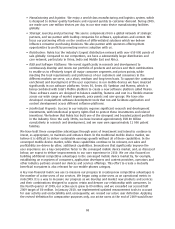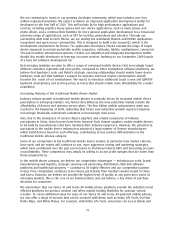Nokia 2009 Annual Report Download - page 65
Download and view the complete annual report
Please find page 65 of the 2009 Nokia annual report below. You can navigate through the pages in the report by either clicking on the pages listed below, or by using the keyword search tool below to find specific information within the annual report.such as device SAR (Specific Absorption Rate) values, available for consumers. For further information on
environmental issues related to Nokia’s supply chain, see “— Suppliers — Corporate Responsibility —
Nokia” above.
Nokia is also a member of Mobile Manufacturers Forum (MMF), an international association of
telecommunications equipment manufacturers with an interest in mobile or wireless
communications. The MMF was formed in 1998 to facilitate joint funding of key research projects and
cooperation on standards, regulatory issues and communications concerning the safety of wireless
technology, accessibility and environmental issues.
Nokia Siemens Networks: Environment
Nokia Siemens Networks’ environmental strategy is to achieve a net positive impact on the
environment. It intends to achieve this through:
• Minimizing its environmental footprint.
• Combining environmental and business benefits for a sustainable solution.
• Maximizing the positive impact of telecommunications on other industries.
In 2009, Nokia Siemens Networks launched the industry’s most comprehensive range of energy
solutions for telecoms operators, combining products and services. Designed to reduce the network
operating costs of new and legacy telecommunications networks, these solutions can reduce power
consumption and CO2 by exploiting more efficient technology and renewable energy.
Nokia Siemens Networks has deployed more than 390 sites running on renewable energy in 25
countries in AsiaPacific, China, Europe, Middle East, Africa and Latin America. Renewable energy will
be the first choice for remote base stations by 2011.
NokiaSiemensNetworkshassettargetsforimprovingtheenvironmentalperformanceofitsproductsand
its facilities. Nokia Siemens Networks has been a member of the WWF Climate Savers program since June
2008, and is committed to improving the energy efficiency of base station products by up to 40 percent
by 2012, reducing energy consumption of buildings by 6% by 2012 and increasing the use of renewable
energy in company operations to 50 percent by the end of 2010. The emissions avoided by these actions
will amount to approximately 2 million tons of CO2 annually compared to the 2007 level.
All of Nokia Siemens Networks’ production sites are included in the scope of the ISO 14001 certification.
Nokia Siemens Networks: Electromagnetic Fields
Nokia Siemens Networks supports the move by the World Health Organization to harmonize global
regulations on electromagnetic fields based on the widely recognized guidelines issued by the
International Commission on NonIonizing Radiation Protection. Nokia Siemens Networks engages
with its customers, including mobile network operators, to make them aware of electromagnetic field
issues and provides detailed instructions to ensure they operate equipment appropriately to keep
local exposure within safe limits. This includes offering training where necessary for customers who
need support in this area, particularly in emerging markets. Furthermore, an important part of Nokia
Siemens Networks’ responsibility in this area is to engage openly in the global public debate and
monitor the latest scientific studies on radio waves and health. Nokia Siemens Networks’
electromagnetic field specialists are members of relevant scientific organizations including the
Bioelectromagnetics Society and the European Bioelectromagnetics Association, and participate in
important scientific events.
63


